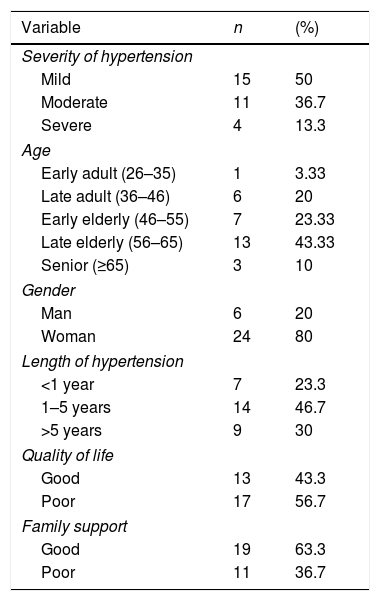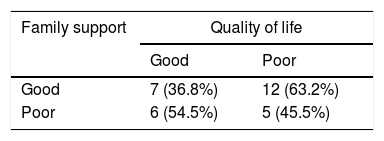The study objective were to determine family support, assess HRQol and examine whether family support correlates to Qol amelioration among patients with hypertension.
MethodQuantitative study with retrospective designs was used to carry out this research. Data collection for Qol and family support were to measure condition of the hypertensive patients for the last month. Meanwhile, blood pressure values as a criterion to select research participants based on the current measurement during the study. Data was collected from 30 participants who selected by using convenience sampling technique from hypertensive patients in Teluk Kenidai Village, Kampar. Ethical consideration was obtained by approval of the research committee in University of Riau.
ResultUnivariate analysis shown that majority of participants are female (24 or 80%), the most of them have suffered from mild hypertension (15 or 50%) and dominated by length of the disease 1–5 years (14 or 46.7%). Descriptively, majority of the participants have good level of Qol (17 or 56.7%) and good of family support (19 or 63.3%). Furthermore, inferential statistic (chi-square) has shown that p value is 0.454>α (0.05) indicates that there is no correlation between family support and Qol.
ConclusionCan be concluded that Qol and family support among hypertensive patients in Teluk Kenidai Village were in good level but statistically, the level of Qol among them significantly was not correlated with their family support.
Hypertension is one of the deadly diseases in the worldwide. Recently, 1 billion or 1 in 4 adult population in the worldwide suffers from this disease. According to a survey conducted by the Word Health Organization (WHO) in 2010, the number of global hypertensive population around 26.6% is men and around 26.1% is women. It was estimated will be increased to 29.2% in 2025 (Apriany, 2012). According to Riskesdas data in 2013 that hypertension is a health issue in Indonesia with prevalence 25.8%.
Hypertension is a silent killer disease with various symptoms in every individual and it is similar with other disease's symptoms. The symptoms are headache/heavy sensation in the neck, dizziness (vertigo), palpitations, fatigue, blurred vision, ringing in the ears (tinnitus), and nosebleeds (Ministry of Health RI, 2014). Hayens et al. (2008) stated that 30% of hypertensive patients tend to mention that they have a poor health status compared to those who are not hypertensive. Poor health status indicates that quality of life is not good. Long high blood pressure (persistent) lead to cause damage the nephron in the renal (kidney failure), heart (coronary heart disease) and brain (causing stroke) if not detected early and receive adequate treatment. Currently, the number of uncontrolled hypertensive patients is increase (Ministry of Health RI, 2014). Patients with hypertension will need family support system to succeed blood pressure control.
The prevalence of hypertension in Indonesia based on ≥18 years of measurement was 25.8%. In conjunction to it, prevalence of hypertension in Riau is 20.9% (MOH, 2013) and Pekanbaru's population who suffer from hypertension counted 12,781 people (Pekanbaru City Health Office, 2010).
Pre-research study with interview to hypertensive patients and their families on February 1, 2017 on 10 revealed that 6 people (60%) stated that they were not able to self-manage their hypertension properly because lack of family support such as not provide hypertension diet, when they want to do BP check there is no family member send them to Puskesmas or clinics, family does not remind them to take anti-hypertension medication. Patients with hypertension complaint that when they got recurrent of the disease, they suffer from physical weakness, dizziness or headaches and psychological disorders (tend to emotionally angry), fatigue and thus affecting their quality of life (Table 1).
Distribution of respondents based on the characteristics of hypertension, age, sex, length of hypertension, family support and quality of life (N=30).
| Variable | n | (%) |
|---|---|---|
| Severity of hypertension | ||
| Mild | 15 | 50 |
| Moderate | 11 | 36.7 |
| Severe | 4 | 13.3 |
| Age | ||
| Early adult (26–35) | 1 | 3.33 |
| Late adult (36–46) | 6 | 20 |
| Early elderly (46–55) | 7 | 23.33 |
| Late elderly (56–65) | 13 | 43.33 |
| Senior (≥65) | 3 | 10 |
| Gender | ||
| Man | 6 | 20 |
| Woman | 24 | 80 |
| Length of hypertension | ||
| <1 year | 7 | 23.3 |
| 1–5 years | 14 | 46.7 |
| >5 years | 9 | 30 |
| Quality of life | ||
| Good | 13 | 43.3 |
| Poor | 17 | 56.7 |
| Family support | ||
| Good | 19 | 63.3 |
| Poor | 11 | 36.7 |
The research method used is correlation, with retrospective and prospective data collection. Retrospectively in this study is to assess the quality of life among hypertensive patients for the last month condition and prospective design to carryout measurement of blood pressure at the time of the study. At the time of data collection the study also carried out blood pressure measurements to identify the classification of hypertension suffered (mild, moderate, severe) (Table 2).
Assessment quality of life for the population conducted by using the International standard and validated WHOQoL questionnaires. Meanwhile assessment family support by using questionnaires with components such as informational, assessment, instrumental and emotional supports.
This research was conducted in the Teluk Kenidai Village, Kampar Regency. The population of this study is hypertensive patients in Kenidai Bay Village. The samples taken in this study were 30 people who met the inclusion criteria; adults and elderly, diagnosed with hypertension, able to communicate, live with family, and have ability to do activity daily living (ADL).
ResultBivariate analysis using chi-square obtained p value=0.454>(α=0.05), the finding can be interpreted that there is no relationship between family support and the quality of life among hypertensive patients in Teluk Kenidai Village.
DiscussionBased on the results of the study, majority of hypertensive patients (15 people or 50%) were suffered from mild hypertension.
The findings of the study have shown that majority hypertensive patients are women (24 people or 80%). Participant of this study majority is women because the study was conducted during the day, when the head of the household (husband) was working outside the home so that more women were found at home.
The study also found that length of hypertension suffered by the patient majority is 1–5 years (14 people 46.7%). In nature, patients with hypertension will check their disease when got symptoms that interfere their daily activities.
The findings also shown that majority of hypertensive patients (13 participants or 43.33%) is the elderly with age 56–65 years old. Physiologically elderly experience changes in blood vessel structure that decrease elasticity of the blood vessels which lead to increase blood pressure and produce hypertension. In detail, this study found that respondents got hypertension in mild age onset and genetically related to their elderly parents disease.
Based on the findings of the study, the majority hypertensive patients’ quality of life is poor (17 respondents or 56.7%). Accordingly, Flanagan (1978 in Mahdi, p. 20), suggested factors associated with quality of life included education, family life, peace of mind, and work. WHOQOL (2004) in Murphy et al. (2000), has defined that quality of life is an individual's perception on his position of life, within context of culture and value system in which the individuals lives and the relationship to their goals, hopes, standards and desires. Respondents in this study more than half had poor quality of life. They experienced headache, dizziness, weakness, sometime palpitation, could not carry out activities as usual because they often got sleep deprivation and have to bedrest. This condition, hypertensive patients feels that the daily activities target cannot be realized comprehensively then lead to decreases the quality of life. The most domains affected by the disease are physical and psychological aspects. Respondents experienced uncomfortable, fatigue on their body and often angry or emotionally sensitive due to hypertension.
Based on the results of the study, majority of hypertensive patients got good level of family support (19 respondents or 63.3%). Indonesian Ministry of Health (1998) has highlighted that family is the smallest unit of the community which consists of the Head of the Family and several people family member who live together in a place under one roof and live with mutual dependences.
In some communities in rural areas, when they have a family members suffer from a disease and fall sick, they will try to help them with traditional remedies then get professional help to take care and cure the disease. In this event, the role of family is to provide family support since onset of the disease such as provide required diet and ensure medication to recover the disease quickly further able to carry out their normal role and functions
ConclusionThe findings of the study have shown that majority of hypertensive patient (15 patient 50%) suffers from mild hypertension. Respondent of this study was dominated by female (24 respondent 80%). The most length of the disease suffered by patient is 1–5 years (14 respondent 46.7%), Majority hypertensive patient have poor level of quality of life (17 respondent or 56.7%), and majority of hypertensive patients got good level of family support for their hypertensive care (19 respondents or 63.3%). Bivariate analysis has found that p value=0.454>α (0.05), can be interpreted that there is no relationship between family support and quality of life among hypertensive patients in Teluk Kenidai Village.
This work was carried during June–November 2017 at Teluk Keniday Village, Kampar. I would like to thank to the head of Teluk Kenidai Village and correspondents for their support in my research.
Black JM, Hawks JH. Medical surgical nursing. 8th edition Canada: Elsevier; 2009.
Friedman DKK. Buku Ajar Keperawatan Keluarga; Riset, teori dan praktik. Jakarta: EGC; 2010.
Price, Wilson. Patofisiologi. Konsep klinis proses-proses penyakit. Penerjemah dr. Brahm U. Pendit. Jakarta: EGC; 2006.
Setiadi. Konsep dan proses keperawatan keluarga. Yogyakarta: graha ilmu; 2008.
Smeltzer, Bare. Buku Ajar Keperawatan Medikal Bedah. Edisi 8 Volume 2. Jakarta: EGC; 2009.
WHO. Quality of life BREF; 2008 http://www.who.int/substanceabuse%20/../whoqolbref/
Peer-review of abstracts of the articles is under the responsibility of the Scientific Committee of Riau International Nursing Conference 2018. Full-text and the content of it is under responsibility of authors of the article.








